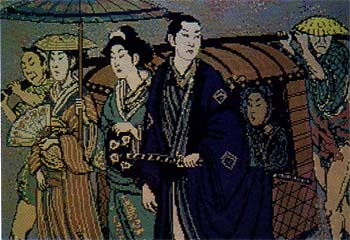news & notes
Every Picture Tells a Story
More powerful personal computers, competition from videogame manufacturers, and a desire to expand the pool of buyers have combined to push text-based-game makers toward graphics-based adventures. As a result, game players are increasingly entranced by the sophisticated displays and complexity of recent game releases.
With Shogun, Infocom has taken another step in its own journey toward the perfect electronic story. Known as one of the premier publishers of computerized text adventures, over the last ten months the company has added graphics to its adventures. The result, says Infocom, is clearer computer/player interaction with enhanced puzzle solving and deeper story lines.
The company isn't leaving its history of text-based adventures behind, however. Rather, it's building on that tradition with graphics elements that enhance the story without distracting from the action. Zork Zero was one of the first graphics-directed stories out of Infocom. That game expanded its context by including graphics puzzles and games, like the Double Fannuci card game, that were only described in previous Zorks.
But Infocom isn't content to rewrite old games or to release sequels. Joe Ybarra, vice president of product development, said that text-based stories and puzzles still make up the firm's main support, but the company wants to expand its horizons.
In the past, Infocom's role-playing games have leaned heavily on fantasy (dragons, dungeons, soothsayers, and such) or science fiction (the only good alien is a dead alien). But the company is eager to expand its inspirational base to other literary genres, and perhaps tap into films as well. Japanese art from the nineteenth century has been used to enhance Shogun, an indication of the illustrative role graphics play in Infocom products.

Moving into new story territory is possible in part because of the company's use of outside developers. Until last fall, the firm created all of its games internally, but its Quarterstaff and BattleTech games both came from outside sources. Last summer, the company hired a graphics art staff to work on illustrating future Infocom releases. Now that the development tools are in place, Ybarra expects Infocom to create its own adventures-of the Quarterstaff caliber-this year.
Besides illustrative graphics, Infocom games are also using more menus, a development which Ybarra said offers an advantage over games that use a parser. For one, it allows better interaction between the player and the computer. It also gives Infocom more control over the pacing of the story. "In terms of computer storytelling, that's a more realistic approach," he said.
Looking into the near future, Ybarra said the complexity of the next generation of games could be a problem because developers may need a 3-to-5-year lead time to create stories, and user demand might change during the development of the game. "It's a situation of having a huge canvas to fill," he said. From text and graphics to artificial intelligence, designers will have a number of options. Ybarra said users may be looking at games encompassing as many as 10-15 floppy disks.
Infocom is also keeping a close eye on cartridge-game makers like Nintendo, who may one day release their own role-playing games. Only by exploiting the power of the personal computer, Ybarra said, can companies like Infocom maintain their standing in the game market.
But rapid hardware changes, a demanding public, and competition from video game makers can't take away what Infocom sees as its mission, said Ybarra, which is to tell the best stories it can the best way it knows how. "The game is the story," he said. "The story is the game."
-
Peter Scisco